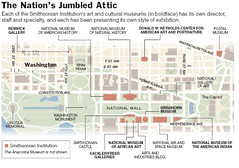The decline of the American empire
The Fourth of July, Independence Day, celebrating the separation of what became the United States from the United Kingdom, is a good day for thinking about the future of the country.
Last Saturday at the Smithsonian Folklife Festival, I was taken aback in the display about Kent, England in the "Roots of Virginia" section because on the maps posted there was a line making the point that the U.S.'s roots start in England. I was taken aback because how could anyone not know this?
In Business Week a couple weeks ago was a commentary piece about China, India, and the U.S., and will the 21st century be the Asian Century, supplanting the United States and the "American Century" (cf. Henry Luce). The piece, "Who Will Rule The 21st Century?," concludes that:
In the end, we'd make the case that American economic leadership will be with us for most, if not all, of the century. It will by no means "rule," as it did at the turn of the 21st century. But it will remain ahead until other nations develop a total economic and social system that works as well. There's a lot more to the world's economic future than a straight-line extrapolation can tell you.
While I think it's true that certain sectors of U.S. industry are quite innovative and forward-looking, mostly after recognizing the move from a U.S. dominated global market to a truly global market with global competitors and global customers (E.g., steel in the world is dominated now by Mittal Steel. Ships are constructed overseas. But companies like Caterpillar and John Deere have risen to the challenge posed by Komatsu. The U.S. computing industry is incredible innovative, even as manufacturing of machines has moved to China. Etc.) certain sectors appear to be incapable of recognizing this reality.
One sad example--being that I am from Michigan--is the U.S. based automobile industry. Yes, I rail about automobility, but the State of Michigan had a great public university system in large part because of taxes paid by the automobile manufacturers. And a great number of once successful cities (Detroit, Pontiac, Flint, Lansing, etc.) thrived around their connection to this industry.
In any case, I think there is a big difference between innovative capacity in the public sector vs. the private sector.
The federal government appears to be particularly hidebound. Something isn't working, and it's getting worse. In many respects the Iraqi debacle isn't much different than the Vietnam debacle. The latter had to do with "the domino theory" the former with an ideological belief that the Mideast could be saved with a dose of "American" democracy. In both cases the ideologies had little to do with the reality within those countries or their regions.
Think right now about how much destruction of international goodwill towards the United States is occuring, because of the war in Iraq. Not to mention the reduction of international tourist visits to the United States, and the decline of the number of foreign students attending U.S. universities as a result of visa requirements and other changes post 9/11.
But municipal government and state government can be pretty hidebound too.
And I wonder how much destruction of value the country can continue to afford.
The problems at the Smithsonian Institution are another example of government failure. In some respects, Congress--given that much of the Smithsonian's budget comes from the federal government--is the ultimate boss of the institution. Few Congresspeople seem to strive for greatness for the country. (A perfect example is how Michigan Congresspeople help to restrict fuel economy requirements on the automobile industry, which only makes U.S.-headquartered companies less competitive. Of course the real issue is a transportation and land use paradigm dependent on oil--which destabilizes the nation economically and militarily.)
There is a piece in last Sunday's New York Times, "This Art Is Your Art, This Art Is My Art," which quotes a document produced during the now disgraced Small Administration:
Our goal is nothing less than to set the standard of museumgoing excellence for the world.
Can we say that most Smithsonian Museums achieve this level of achievement? Speaking of globalization, the Smithsonian has patrons that come from all over the world, and patrons that have visited many other places and museums.
The Office of the Undersecretary of Art iniatiated an external review panel to look at this question, and many of the museums were found capable of improvement. Instead of being reflective, the directors and their boards have challenged the report, accusing it of being a set up job and biased. But the report was all about achieving greatness.
It makes sense to me that in Washington, DC, the new heart of darkness in some respects, that the culture that favors mediocrity is so entrenched.

Click on the article to access this graphic in full-size.
The NYT piece quickly analyzes each museum and all are found wanting. From the article:
And so America’s museum wanders on. What to do? Needless to say, there are no easy answers; maybe no right answers period. More money from the government to the Smithsonian, and from the Smithsonian to its art museums would be a start. Even more useful would be some organized way to generate private donations. With some extra cash, the Hirshhorn could buy more art and the American Art Museum could buy better art, and get back to doing the kind of think-piece shows it does well. These shows will never be blockbusters. So what? James Smithson’s gift wasn’t for blockbusters. It was for information, knowledge.
Are our political and government institutions capable of transformation? Is our culture capable of deliberation, reflection, and participation?
Something to think about when you watch tonight's fireworks.

Fourth of July fireworks behind the Washington Monument, 1986. Image by Staff Sergeant Lono Kollars, via Wikipedia.
Labels: bad government, good government, government oversight, Growth Machine



0 Comments:
Post a Comment
<< Home